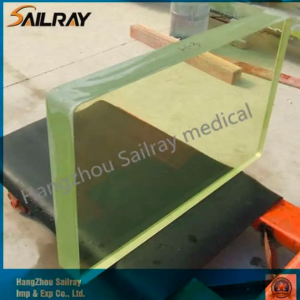In the field of modern medicine, technology plays a vital role in providing accurate diagnosis and effective treatment. X-ray machines are one such technology that revolutionized the field of diagnosis. X-rays can penetrate the body to capture images of internal structures, helping doctors identify potential health problems. However, with great power comes great responsibility, and the use of X-rays also brings potential risks to patients and healthcare professionals.
To mitigate these risks, the use of X-ray shielding lead glass has become commonplace in medical facilities. This special glass is designed to protect individuals from the harmful effects of radiation while still allowing X-ray transmission to capture clear images. This remarkable material has become an essential part of radiology departments, dental offices and other medical facilities where X-rays are performed regularly.
The main function of X-ray shielding lead glass is to contain or block harmful radiation emitted by X-ray machines. Without proper shielding, people near the X-ray room can be exposed to dangerous levels of radiation, resulting in potential health hazards. Additionally, using lead glass helps maintain privacy and confidentiality during X-ray examinations because it prevents radiation from spreading beyond the intended area.
In addition, the use of X-ray shielding lead glass also benefits the safety of healthcare professionals operating X-ray machines. Radiology technicians, dentists, and other workers who are frequently exposed to X-rays face a higher risk of radiation exposure. By incorporating lead glass into the design of X-ray rooms and equipment, the overall safety of these personnel is greatly improved, reducing the long-term health risks associated with radiation exposure.
In addition to its protective properties, X-ray shielding lead glass offers superior optical clarity, enabling high-quality imaging during X-ray surgery. This is critical for accurate diagnosis and treatment planning, as any distortion or occlusion in the image can lead to misunderstanding by healthcare providers. Therefore, the use of lead glass ensures that the X-ray images produced are of the highest possible quality, allowing doctors to make informed decisions about patient care.
It is important to note that the use of X-ray shielding lead glass is not limited to medical applications. This versatile material can also be used in industrial settings where X-ray inspection and testing is performed. Whether for non-destructive testing of materials, safety screening or industrial imaging, lead glass plays a vital role in protecting workers and the surrounding environment from radiation hazards.
In summary, the use of X-ray shielding lead glass in modern medical facilities is critical to ensuring the safety of patients and healthcare professionals during X-ray procedures. Its ability to effectively block harmful radiation while providing clear imaging capabilities makes it an indispensable component in radiology and diagnostic imaging. As technology continues to advance, X-ray shielding lead glass will undoubtedly remain vital in the pursuit of safe and effective healthcare practices.
Post time: Jan-22-2024



